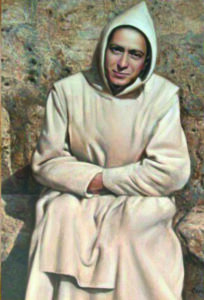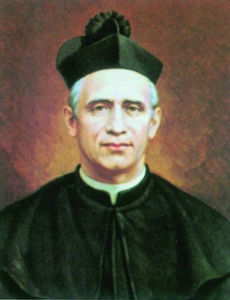April Saints
Saint Rafael Arnáiz Barón
(1911-1938)
Rafael Arnáiz Barón was born, the eldest of four, into a well-to-do Christian family of Burgos, Spain. He attended several schools run by Jesuits and his sensitivity to spiritual topics and to art was apparent from boyhood. He demonstrated an open, joyful attitude to the world, combined with exuberant good humour, respect and humility. Bouts of fever and pleurisy interrupted his education, and his father consecrated him to Our Lady of the Pilar in Zaragoza.
In 1930, as he embarked on architectural studies in Madrid, Rafael began his deeper commitment to Christ, starting an intense prayer life. He was described by contemporaries as being lively, extroverted and artistic. Relations introduced him to the Cistercian Monastery of San Isidro de Dueñas whose beauty and prayerful atmosphere attracted him.
He was called up by the army but declared unfit for active duty. At age 23, he abandoned his studies and entered the monastery. Rafael said this decision had not been prompted by suffering or disappointments but rather by God, who, in his infinite goodness had given him far more in life than he deserved. He felt deeply suited to the monastic rhythm of Gregorian chant and the Liturgy of the Hours. Four months later, after an austere Lent, he was smitten by a serious form of diabetes mellitus which forced him to go home for treatment. Indeed, he was obliged to go back and forth between his home and the monastery again and again between 1935 and 1937, at the height of the Spanish Civil War.
On his final return to the monastery, he was made an oblate, taking the last place and living on the fringes of the community. Canon law at the time did not permit a person in such poor health to take monastic vows.
Rafael died in the monastery’s infirmary on 26 April 1938 after a final attack of his disease. He was given a very short span of life on earth but during his time he functioned on spiritual and intellectual levels unknown to most. His existence was quite simply a continual seeking after unity with God. Humiliation was his constant companion, but his one desire was to live in order to love: to love Jesus, Mary, the Cross, his Trappist monastery. The Pope has proposed him as a model for young people today.
St Rafael, teach us to devote ourselves to loving God and our Christian calling.
Source: Internet – various
St Giovanni Battista Piamarta
(1841-1913)
Giovanni Battista Piamarta was born in Brescia into a poor household. His father was a barber.
His mother died when he was nine, after which he spent time living in the slums of the town. His maternal grandfather helped him by sending him to the Oratory of Saint Thomas.
He was ordained to the priesthood on 23 December 1865 and began his pastoral mission in Carzago Riviera, Bedizzole, spending his first two decades in intense pastoral work, and is remembered as a priest "zealous, excellent, flawless in everything." In that time he was appointed as the priest, and later director, of the parish of Saint Alexander and later as the pastor of Pavone del Mella.
Brescia was in the process of industrialisation and Giovanni identified with the difficulties and hopes of disadvantaged adolescents due to his own experiences on the streets as a child.
With Pietro Capetti and the Catholic Movement he started the Institute Artigianelli for the vocational and Christian education of the poorest children and adolescents on 3 December 1886. The ‘Workman's Institute’ grew in workspaces and buildings, and a great number of adolescents received an adequate technical education.
In 1889, he and Giovanni Bonsignori began the Agricultural Colony of Remedello. As a result, a range of the religious who shared the ideals and labours of the mission gathered around him. In March 1900 he established the Congregation of the Holy Family of Nazareth, known as ‘Piamartinis,’ to continue the work of technical Christian education around the world, in Italy, Angola, Mozambique, Brazil and Chile. Giovanni Battista Piamarta died in Remedello on 25 April 1913 after a life spent in the service of God and his neighbour. He is the patron of jobseekers.
St Giovanni, inspire us to work for the betterment of the poor and underprivileged.
Source: https://anastpaul.com/2019/04/25/
Tagged as: July Saints, Saint Rafael Arnáiz Barón, St Giovanni Battista Piamarta
Comments are closed.



 Entries(RSS)
Entries(RSS)